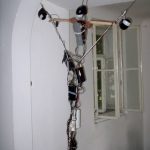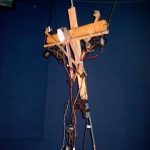Electric Jesus IIFirst occasion of Electric Jesus appeared at the TURNING SOUNDS 2 seminar, Warzsawa, may 2004. Check this link http://absurdevidence.radiostudent.si/borut/zvok_kot_metafora/ or here ../zvok_kot_metafora/.
Ideas are more or less the same, only that in this new materialization some more relations emerged. Together with some new reveletions related to the (conceptual) world of algorythms. Like a need for self sustained/ self-propelled systems.
The sculpture/ installation is denoted as miniature, since it is just a quick realization with available materials.
The heart of it is in some sense the kitchen mixer motor (which has power and some reduction of speed – translation into torque), but not enough. Why? Because for self-propelled system one needs it to be able to almost lift the whole sculpture (or at least to shake it). This represents the shoulders and arms of “Jesus”.
Another heart are the IR motion sensing devices (borrowed from some future object). This add to movement and sound of “Jesus”. Here they are four, but should be reduced to three.
The body is built out of coarsely woven electrical cables (low voltage, signal coaxial and mains…) and the black boxes (modulators, a theremin sensor, etc…). The idea of cables is clear – it’s the veins of the body, the boxes are functional organs, sensors are sensing organs. Simple, because we humans build machines in the image of ourselves, of course.
- Little Jesus
- Techno Jesus
- Pentagram Jesus
// below is the text that somehow relates to the above, but in the area of music. But is broader, more universal… it is still in the production phase.
Against the aestetisation
intro:
The music often remains in the domain of the musical – which means (very simplified) that the works of some experimental artists have that superficial glow (“a poetic dimension”, etc.) that I call aesthetic – and that it often completely covers the motives for exploration into the unknown (which is the high point of experimentation).
Aestetisation is for me closely linked to superficiality (or sensation). On the other hand the sensing is closely linked to the process of understanding (-> demystification), and has to do with unveiling (of the seven veils) – what one searches for seems to be the truth (-> Truth) – which could eventually be meat (or myth)…
The superficial sensing (skin-deep…) does not bring understanding, instead it brings mystification, which is a sort of “instant” knowing. Elsewhere I described myths as “complex bodies of meaning” – the systems/ structures of thought – in some ways “machines for production of meaning”. They do not bring understanding and do not allow to be decomposed easily. However, we are made to be thinking with “bodies of meaning”. Therefore we always “construct” complex issues into something that we can take along and use instantly. But we cannot carry around the understanding itself – to achieve this, we must perform a deconstruction (or demystification) on the spot – each and every time… Each time the results can be very different.
In their most simple (superficial) appearances myths are just stories without any deeper understanding. Such stories are almost timeless – the root of culture (and our patterns of public behaviour and relations). They are symbols, stereotypes, etc… They are the basis of our “collective mind”. One does not doubt them – therefore they are the cohesive cultural element – we all happen to agree upon them.
Aestetisation = Mystification
But just as they were composed, they can be decomposed/ deconstructed, and what one finds there is the history of human kind, the “nature of human” and civilisation. Since I deal with machines, I want to know what is the root of human fascination with them. Of course (I know that already) – it is the fascination of the humans with themselves – their ability (and inability) for achieving perfection. Greek philosopher Plato described the beauty as the human soul’s memory of the glimpse of the things seen at gods residence at Olympus. In other words: beauty, goodness, etc…: are universal ideas that are transcendent – the perfection itself.
The perfection and beauty therefore go hand in hand. The aestetics is the domain of the beautiful – or so they say. It is a derived term (as such it is more precise), describing the human ability “to sense the quality” of things. Here we are much closer to understanding – to the process of gaining knowledge and… knowing. It is no more just about the beauty of things. The departure is noted as the gap between the Platonists and Aristotelians.
Meat = Myth?
In my confrontation to the point of unnecessary aestetisation (when it is acting as a layer of mystification, covering the “true meaning” of things, or just covering “the sweet nothing”, or just being there without any purpose – covering and hiding away the “meaning” – even when there is meaning), I don’t want to go as far as to describe it as unnecessary. Here I point out to another “classic” confrontation – the dionysiac and the appolinic – the confrontation between body and mind. To translate that to “artistic objects” I would describe it as the predominance of “skin” against “the bones” (or meat – but this already carries a sexual quality/ in today’s prevalence of pornography it is useless to describe “substance”) – the superficial (visual?) against the structure – all in all: the myth against the meaning.
Art (again understood as a derivation – a higher level of abstraction – of human ability to sense and reconstruct reality – mainly for communication reasons) has roots in both: the ritualistic approaches concerned with body (and emotional) transformations and the (more) transcendental approaches concerned with spiritual transformations. First has to do with sensing, feeling, knowing and the second with understanding (but also with knowing). Both methods return an answer: the first method is much quicker (instant?) based on experiential, the second method is slower, but it can provide a variety of results.
However, if one chooses to explore, experiment, to gain knowledge, it is only the second method that produces new results. In any case, experiental method is more or less inevitable to all of us – but individualization (a departure from the common/ collective roots… whatever for?) comes from the second method. In experimental art it is the only viable method, because it uncovers the truth (or better: the new; new view of inner/inter-relations…, etc. ). It is the only changing element – it defines new points of reference to observe the world – and see the Truth.
Art as the last stand of the Humanists?
Art has not always been the domain of critical point of view – it was introduced by the avantguardists in the 20th Century. At the same time everything that was without critical position became purely decorative. And decoration is the skin that hides the meaning. With today’s product design it almost the only distinguishing quality between the products. Recently it is almost the only thing that adds to the symbolic value. The symbolic value is the only part of a product that generates profit. This is what I call mystification. Hiding the true value (-> the meaning) of a thing.
But why did art become recently about the only area for humanistic ideas? Why did the so-called anti-globalists just recently tried to enter the galleries to present the social issues? Did the art area (artists as “creators”) managed to keep a certain dose (doze?) of moral integrity in spite of the very strong push from the (art) market? If this is the fact – it is on one hand a gain for the artistic position, but on the other hand a kind of loss for the social struggle. Art is marginalized, when it is not part of pop-culture – and this then means that the social issues are also marginalized. A Russian performer Aleksandr Brenner recently wanted to point out to the (Slovene) artists that they should be aware that they are adding to the capitalistic and anti-social relationships – that they are sold out.
While this is very very true it is a bit funny to demand from the artistic world a kind of humanistic position. Was it not even very recently that the humanistic position was performed elsewhere? What happend to the philosophers, to the social critique from the specialized academic institutions? Did they all join the same marginal areas as art – or did they just become a kind of performers? Like Aleksandr Brenner? Performers and actors are sometimes looked at as one and the same (which for me is a total mistake – actors are clowns and such…). One wonders…
2D, 3D, 4D …
To return briefly to “bodies”. When we internalize something as a kind of memory we make a kind of mind image of it. Be it 2-dimensional or 3-dimensional – it is a reduced system of evaluation – a kind of “melting stone” (“that can change any cheap metal to gold”). This is a kind of simple translation (in the form of a simple story) of what the alchimists were doing. The point, of course, is elsewhere: The alchimists were searching for Truth – the gold representing it, and the cheap metal just being the ordinary omnipresent material (world).
But the hard point with the bodies becomes when it is clearly not humanly possible to visualize anything more complex than the 3-dimensional dynamicly changing object. This is usually related to as the 4-dimension space. The problem is sometimes overcome with observation of (dynamic) patterns that we can observe while the system is changing. But here it becomes really abstract. Primary correlations are lost – a new object emerges. It is funny when people relate to the perfect fractal images as representation of the chaos theory… Something went terrible wrong along the road…
A very similar explanation is possible with the observation of various degrees of juggler’s skills. A juggler with one ball is even not thought of as a juggler, almost anybody can learn quickly using two balls. It becomes hard with three balls – with one ball always in the mid air. I believe that the four balls represent the ultimate skill. The fascination of the observer here starts with the introduction of three balls. This is the point where it becomes “magical”. Our eyes (-> brain) can no longer follow the “logic” (-> the technology) of action, so we transfer our understanding to observing the pattern (a new “object” or “body” or “abstraction”, as described above). A translation process between the old understanding and new understanding is that of fascination – or any other kind of alienating effect (like the passing of time), described by Victor Schklovsky as “estrangement”.
It is of course about production of reality. Last remarks are not valid only for language (a production of symbolic bodies) but also for any other kind of bodies.
My point here (and critique) has to do with the use of techniques of fascination which hide away all the ideas involved in the production process – in the structuring of object. It so easily happens that the end “product” has nothing to do with ideas that construct it. Therefore bare bones and veins are neccessary, and skin is not. Mistakes or failures are also “demystifiers” and perfection is sin. In art.
To finish (for now) as quickly as possible:
When I hear/see aestetisation I usually start thinking that there is no idea behind. So if later on I find it, I am mostly sad that it was not projected forward. This is not tragic – just a conceptual mistake. It does not add to the knowledge – it adds to noise. And what is noise? It is something that is all around us – something that carries no usefull information whatsoever. Filter it out!


